Discovery of Tryptanthrin and Its Derivatives and Its Activities against NSCLC In Vitro via Both Apoptosis and Autophagy Pathways
Abstract
1. Introduction
2. Results
2.1. Chemistry
2.2. Anti-Proliferative Activity
2.3. Cell Morphological Analysis
2.4. Cell Apoptosis Analysis and Effect on the Mitochondrial Membrane Potential (DΨm)
2.5. Cell Cycle Analysis
2.6. Effect of C1 on Expressions of Autophagy Related Protein LC3
3. Discussion
4. Materials and Methods
4.1. Chemistry and Instruments
4.2. Pharmacology
4.2.1. Cell Culture and Treatment
4.2.2. MTT Assay
4.2.3. Cell Migration Assay
4.2.4. Hoechst33258 Staining
4.2.5. Transmission Electron Microscopy
4.2.6. Annexin V-FITC/Propidium Iodide Dual Staining Assay
4.2.7. Measurement of Mitochondrial Membrane Potential (DΨm)
4.2.8. Cell Cycle Analysis
4.2.9. Western Blotting Analysis
4.2.10. Statistical Analysis
5. Conclusions
Supplementary Materials
Author Contributions
Funding
Institutional Review Board Statement
Informed Consent Statement
Data Availability Statement
Conflicts of Interest
References
- Jahng, Y. Progress in the studies on tryptanthrin, an alkaloid of history. Arch. Pharm. Res. 2013, 36, 517–535. [Google Scholar] [CrossRef] [PubMed]
- Zeng, Q.; Luo, C.; Cho, J.; Lai, D.; Shen, X.; Zhang, X.; Zhou, W. Tryptanthrin exerts anti-breast cancer effects both in vitro and in vivo through modulating the inflammatory tumor microenvironment. Acta Pharm. 2021, 71, 245–266. [Google Scholar] [CrossRef] [PubMed]
- Popov, A.; Klimovich, A.; Styshova, O.; Moskovkina, T.; Shchekotikhin, A.; Grammatikova, N.; Dezhenkova, L.; Kaluzhny, D.; Deriabin, P.; Gerasimenko, A.; et al. Design, synthesis and biomedical evaluation of mostotrin, a new water soluble tryptanthrin derivative. Int. J. Mol. Med. 2020, 46, 1335–1346. [Google Scholar] [CrossRef] [PubMed]
- Latypova, D.K.; Shmakov, S.V.; Pechkovskaya, S.A.; Filatov, A.S.; Stepakov, A.V.; Knyazev, N.A.; Boitsov, V.M. Identification of Spiro-Fused Pyrrolo[3,4-a]pyrrolizines and Tryptanthrines as Potential Antitumor Agents: Synthesis and In Vitro Evaluation. Int. J. Mol. Sci. 2021, 22, 11997. [Google Scholar] [CrossRef] [PubMed]
- Lee, S.; Kim, D.C.; Baek, H.Y.; Lee, K.D.; Kim, Y.C.; Oh, H. Anti-neuroinflammatory effects of tryptanthrin from Polygonum tinctorium Lour. in lipopolysaccharide-stimulated BV2 microglial cells. Arch. Pharm. Res. 2018, 41, 419–430. [Google Scholar] [CrossRef]
- Hwang, J.M.; Oh, T.; Kaneko, T.; Upton, A.M.; Franzblau, S.G.; Ma, Z.; Cho, S.N.; Kim, P. Design, synthesis, and structure-activity relationship studies of tryptanthrins as antitubercular agents. J. Nat. Prod. 2013, 76, 354–367. [Google Scholar] [CrossRef]
- Bandekar, P.P.; Roopnarine, K.A.; Parekh, V.J.; Mitchell, T.R.; Novak, M.J.; Sinden, R.R. Antimicrobial activity of tryptanthrins in Escherichia coli. J. Med. Chem. 2010, 53, 3558–3565. [Google Scholar] [CrossRef]
- Kataoka, M.; Hirata, K.; Kunikata, T.; Ushio, S.; Iwaki, K.; Ohashi, K.; Ikeda, M.; Kurimoto, M. Antibacterial action of tryptanthrin and kaempferol, isolated from the indigo plant (Polygonum tinctorium Lour.), against Helicobacter pylori-infected Mongolian gerbils. J. Gastroenterol. 2001, 36, 5–9. [Google Scholar] [CrossRef]
- Tsai, Y.C.; Lee, C.L.; Yen, H.R.; Chang, Y.S.; Lin, Y.P.; Huang, S.H.; Lin, C.W. Antiviral Action of Tryptanthrin Isolated from Strobilanthes cusia Leaf against Human Coronavirus NL63. Biomolecules 2020, 10, 366. [Google Scholar] [CrossRef]
- Miao, S.; Shi, X.; Zhang, H.; Wang, S.; Sun, J.; Hua, W.; Miao, Q.; Zhao, Y.; Zhang, C. Proliferation-attenuating and apoptosis-inducing effects of tryptanthrin on human chronic myeloid leukemia K562 cell line in vitro. Int. J. Mol. Sci. 2011, 12, 3831–3845. [Google Scholar] [CrossRef]
- Yu, S.T.; Chen, T.M.; Tseng, S.Y.; Chen, Y.H. Tryptanthrin inhibits MDR1 and reverses doxorubicin resistance in breast cancer cells. Biocheml. Biophys. Res. Commun. 2007, 358, 79–84. [Google Scholar] [CrossRef]
- Jao, C.W.; Lin, W.C.; Wu, Y.T.; Wu, P.L. Isolation, structure elucidation, and synthesis of cytotoxic tryptanthrin analogues from Phaius mishmensis. J. Nat. Prod. 2008, 71, 1275–1279. [Google Scholar] [CrossRef]
- Pattarawarapan, M.; Wiriya, N.; Hongsibsong, S.; Phakhodee, W. Divergent Synthesis of Methylisatoid and Tryptanthrin Derivatives by Ph3P-I2-Mediated Reaction of Isatins with and without Alcohols. J. Org. Chem. 2020, 85, 15743–15751. [Google Scholar] [CrossRef]
- Sudheendran Leena, S.; Kaul, G.; Akhir, A.; Saxena, D.; Chopra, S.; Deepthi, A. Green synthesis and antibacterial evaluation of spiro fused tryptanthrin-thiopyrano[2,3-b]indole hybrids targeting drug-resistant S. aureus. Bioorg. Chem. 2022, 128, 106046. [Google Scholar] [CrossRef]
- Kawakami, J.; Kadowaki, T.; Ikeda, M.; Habata, Y.; Ito, S.; Kitahara, H. Spectral Characteristics of Highly Fluorescent 2-(N,N-dimethylamino)tryptanthrin. Trans. Mater. Res. Soc. Jpn. 2016, 41, 143–146. [Google Scholar] [CrossRef]
- Catanzaro, E.; Betari, N.; Arencibia, J.M.; Montanari, S.; Sissi, C.; De Simone, A.; Vassura, I.; Santini, A.; Andrisano, V.; Tumiatti, V.; et al. Targeting topoisomerase II with trypthantrin derivatives: Discovery of 7-((2-(dimethylamino)ethyl)amino)indolo[2,1-b]quinazoline-6,12-dione as an antiproliferative agent and to treat cancer. Eur. J. Med. Chem. 2020, 202, 112504. [Google Scholar] [CrossRef]
- Utkina, N.K.; Denisenko, V.A. Ophiuroidine, the first indolo 2,1-b quinazoline alkaloid from the Caribbean brittle star Ophiocoma riisei. Tetrahedron Lett. 2007, 48, 4445–4447. [Google Scholar] [CrossRef]
- Yang, D.; Zhang, S.; Fang, X.; Guo, L.; Hu, N.; Guo, Z.; Li, X.; Yang, S.; He, J.C.; Kuang, C.; et al. N-Benzyl/Aryl Substituted Tryptanthrin as Dual Inhibitors of Indoleamine 2,3-Dioxygenase and Tryptophan 2,3-Dioxygenase. J. Med. Chem. 2019, 62, 9161–9174. [Google Scholar] [CrossRef]
- Wang, J.; Yun, D.; Yao, J.; Fu, W.; Huang, F.; Chen, L.; Wei, T.; Yu, C.; Xu, H.; Zhou, X.; et al. Design, synthesis and QSAR study of novel isatin analogues inspired Michael acceptor as potential anticancer compounds. Eur. J. Med. Chem. 2018, 144, 493–503. [Google Scholar] [CrossRef]
- Klein, L.L.; Tufano, M.D. Synthesis of Substituted Isatins. Tetrahedron Lett. 2013, 54, 1008–1011. [Google Scholar] [CrossRef]
- Runwal, G.; Stamatakou, E.; Siddiqi, F.H.; Puri, C.; Zhu, Y.; Rubinsztein, D.C. LC3-positive structures are prominent in autophagy-deficient cells. Sci. Rep. 2019, 9, 10147. [Google Scholar] [CrossRef] [PubMed]
- Klionsky, D.J.; Petroni, G.; Amaravadi, R.K.; Baehrecke, E.H.; Ballabio, A.; Boya, P.; Bravo-San Pedro, J.M.; Cadwell, K.; Cecconi, F.; Choi, A.M.K.; et al. Autophagy in major human diseases. EMBO J. 2021, 40, e108863. [Google Scholar] [CrossRef] [PubMed]
- Thorburn, A. A new mechanism for autophagy regulation of anti-tumor immune responses. Autophagy 2020, 16, 2282–2284. [Google Scholar] [CrossRef]
- Varusai, T.M.; Jupe, S.; Sevilla, C.; Matthews, L.; Gillespie, M.; Stein, L.; Wu, G.; D’Eustachio, P.; Metzakopian, E.; Hermjakob, H. Using Reactome to build an autophagy mechanism knowledgebase. Autophagy 2021, 17, 1543–1554. [Google Scholar] [CrossRef]
- Mariño, G.; Niso-Santano, M.; Baehrecke, E.H.; Kroemer, G. Self-consumption: The interplay of autophagy and apoptosis. Nat. Rev. Mol. Cell Biol. 2014, 15, 81–94. [Google Scholar] [CrossRef] [PubMed]
- Xi, H.; Wang, S.; Wang, B.; Hong, X.; Liu, X.; Li, M.; Shen, R.; Dong, Q. The role of interaction between autophagy and apoptosis in tumorigenesis. Oncol. Rep. 2022, 48, 208. [Google Scholar] [CrossRef]
- Song, S.; Tan, J.; Miao, Y.; Li, M.; Zhang, Q. Crosstalk of autophagy and apoptosis: Involvement of the dual role of autophagy under ER stress. J. Cell. Physiol. 2017, 232, 2977–2984. [Google Scholar] [CrossRef]
- Mizushima, N.; Levine, B. Autophagy in Human Diseases. N. Engl. J. Med. 2020, 383, 1564–1576. [Google Scholar] [CrossRef]
- Rousseau, A.; Bertolotti, A. Regulation of proteasome assembly and activity in health and disease. Nat. Rev. Mol. Cell Biol. 2018, 19, 697–712. [Google Scholar] [CrossRef]
- Siegel, R.L.; Miller, K.D.; Fuchs, H.E.; Jemal, A. Cancer Statistics, 2021. CA Cancer J. Clin. 2021, 71, 7–33. [Google Scholar] [CrossRef]
- Herbst, R.S.; Morgensztern, D.; Boshoff, C. The biology and management of non-small cell lung cancer. Nature 2018, 553, 446–454. [Google Scholar] [CrossRef]
- Molina, J.R.; Yang, P.; Cassivi, S.D.; Schild, S.E.; Adjei, A.A. Non-small cell lung cancer: Epidemiology, risk factors, treatment, and survivorship. Mayo Clin. Proc. 2008, 83, 584–594. [Google Scholar] [CrossRef]
- Kroemer, G.; Mariño, G.; Levine, B. Autophagy and the integrated stress response. Mol Cell 2010, 40, 280–293. [Google Scholar] [CrossRef]
- Dang, S.; Yu, Z.M.; Zhang, C.Y.; Zheng, J.; Li, K.L.; Wu, Y.; Qian, L.L.; Yang, Z.Y.; Li, X.R.; Zhang, Y.; et al. Autophagy promotes apoptosis of mesenchymal stem cells under inflammatory microenvironment. Stem Cell Res. Ther. 2015, 6, 247. [Google Scholar] [CrossRef]
- Zhang, M.; Su, L.; Xiao, Z.; Liu, X.; Liu, X. Methyl jasmonate induces apoptosis and pro-apoptotic autophagy via the ROS pathway in human non-small cell lung cancer. Am. J. Cancer Res. 2016, 6, 187–199. [Google Scholar]
- Yim, W.W.Y.; Mizushima, N. Lysosome biology in autophagy. Cell Discov. 2020, 6, 12. [Google Scholar] [CrossRef]
- Rebecca, V.W.; Amaravadi, R.K. Emerging strategies to effectively target autophagy in cancer. Oncogene 2016, 35, 1–11. [Google Scholar] [CrossRef]
- Guo, J.Y.; Xia, B.; White, E. Autophagy-mediated tumor promotion. Cell. 2013, 155, 1216–1219. [Google Scholar] [CrossRef]
- Zhan, L.; Zhang, Y.; Wang, W.; Song, E.; Fan, Y.; Li, J.; Wei, B. Autophagy as an emerging therapy target for ovarian carcinoma. Oncotarget 2016, 7, 83476–83487. [Google Scholar] [CrossRef]
- Amaravadi, R.; Kimmelman, A.C.; White, E. Recent insights into the function of autophagy in cancer. Genes Dev. 2016, 30, 1913–1930. [Google Scholar] [CrossRef]
- Bertheloot, D.; Latz, E.; Franklin, B.S. Necroptosis, pyroptosis and apoptosis: An intricate game of cell death. Cell Mol. Immunol. 2021, 18, 1106–1121. [Google Scholar] [CrossRef] [PubMed]
- Tang, F.; Hu, P.; Yang, Z.; Xue, C.; Gong, J.; Sun, S.; Shi, L.; Zhang, S.; Li, Z.; Yang, C.; et al. SBI0206965, a novel inhibitor of Ulk1, suppresses non-small cell lung cancer cell growth by modulating both autophagy and apoptosis pathways. Oncol. Rep. 2017, 37, 3449–3458. [Google Scholar] [CrossRef] [PubMed]
- Eden, E.R.; Huang, F.; Sorkin, A.; Futter, C.E. The role of EGF receptor ubiquitination in regulating its intracellular traffic. Traffic 2012, 13, 329–337. [Google Scholar] [CrossRef] [PubMed]
- Guan, L.; Yang, H.; Cai, Y.; Sun, L.; Di, P.; Li, W.; Liu, G.; Tang, Y. ADMET-score—A comprehensive scoring function for evaluation of chemical drug-likeness. Med. Chem. Commun. 2019, 10, 148–157. [Google Scholar] [CrossRef]
- Wang, J.; Urban, L.; Bojanic, D. Maximising use of in vitro ADMET tools to predict in vivo bioavailability and safety. Expert Opin. Drug Metab. Toxicol. 2007, 3, 641–665. [Google Scholar] [CrossRef]
- Waring, M.J.; Arrowsmith, J.; Leach, A.R.; Leeson, P.D.; Mandrell, S.; Owen, R.M.; Pairaudeau, G.; Pennie, W.D.; Pickett, S.D.; Wang, J.; et al. An analysis of the attrition of drug candidates from four major pharmaceutical companies. Nat. Rev. Drug Discov. 2015, 14, 475–486. [Google Scholar] [CrossRef]
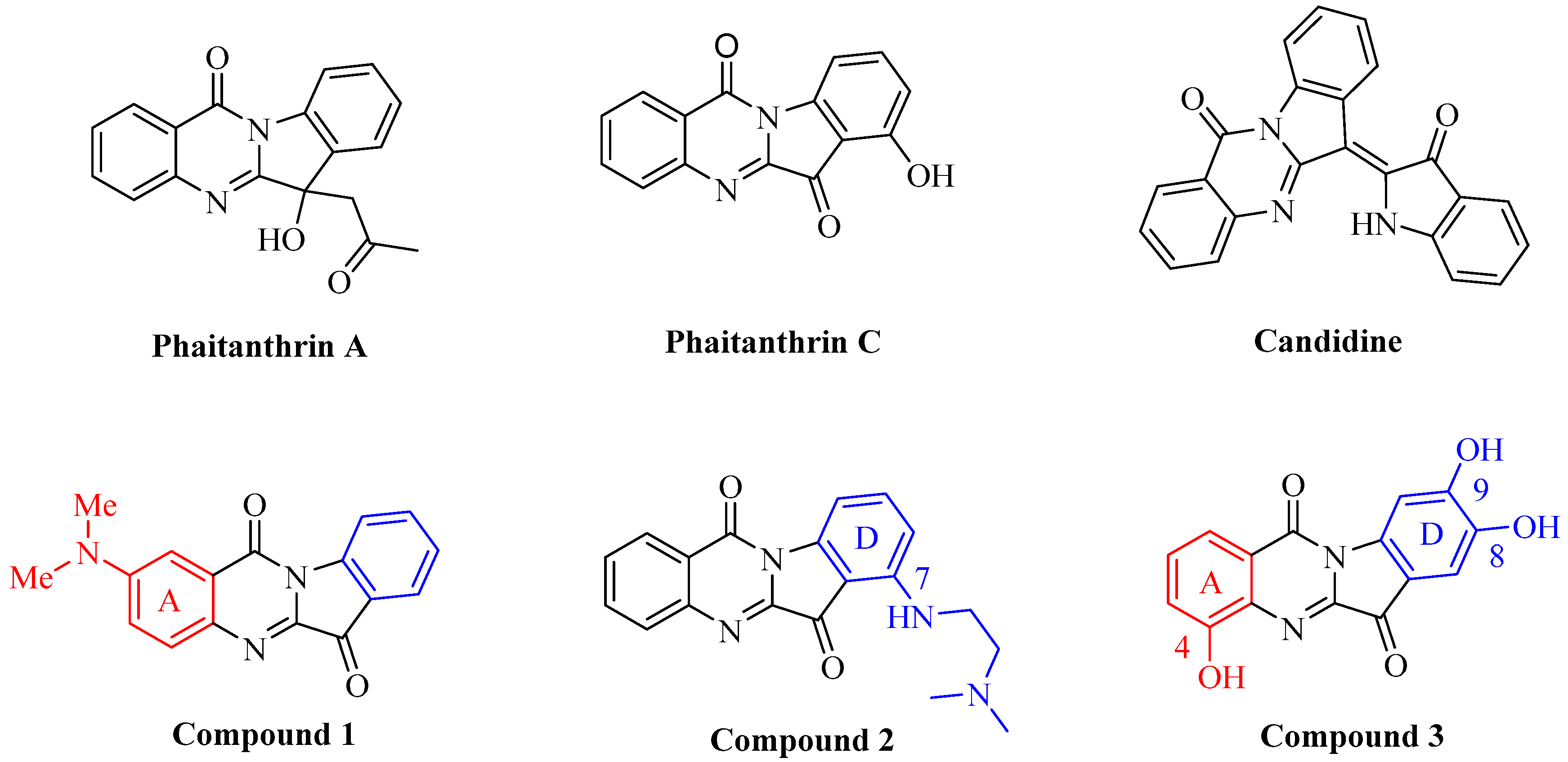
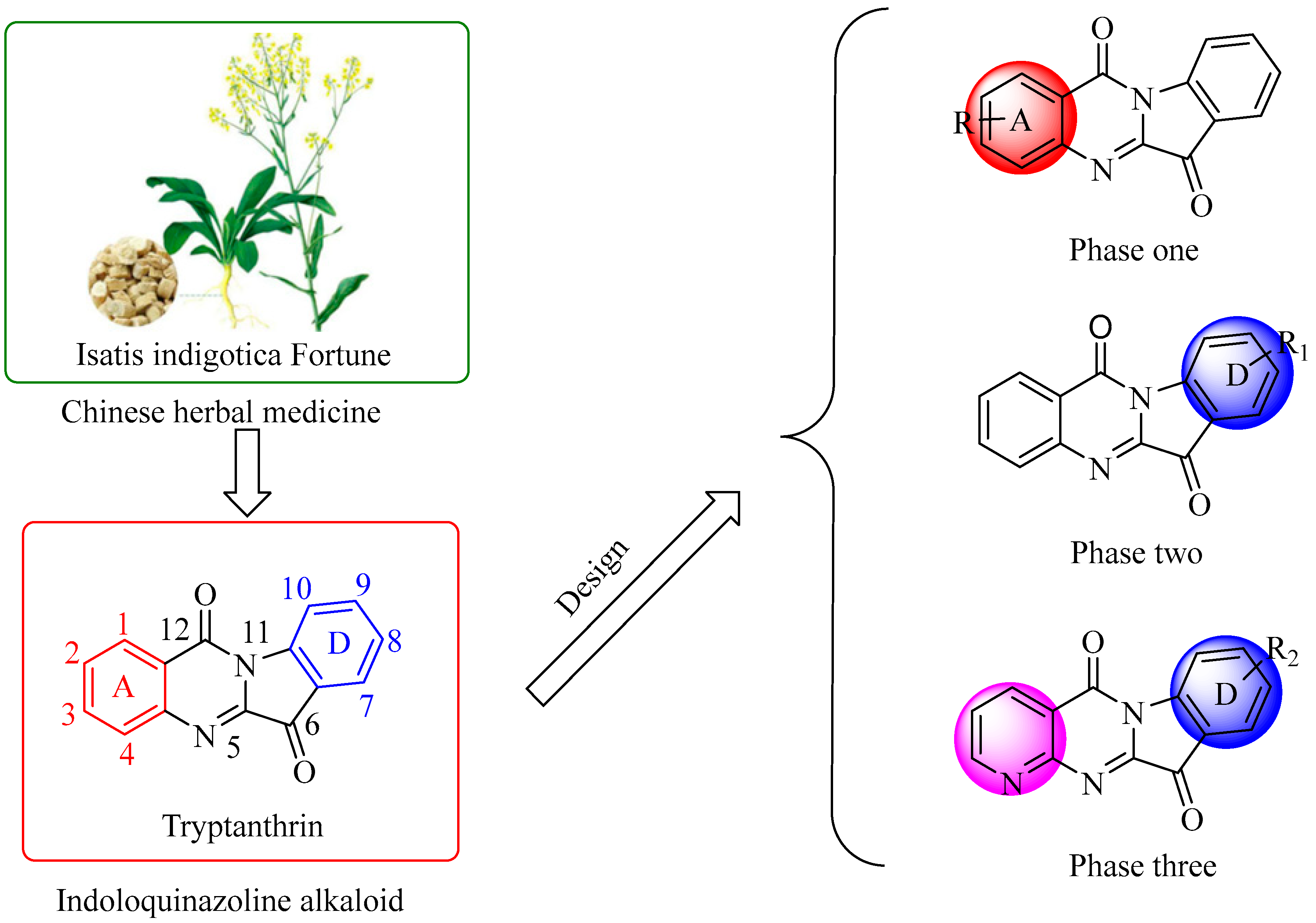
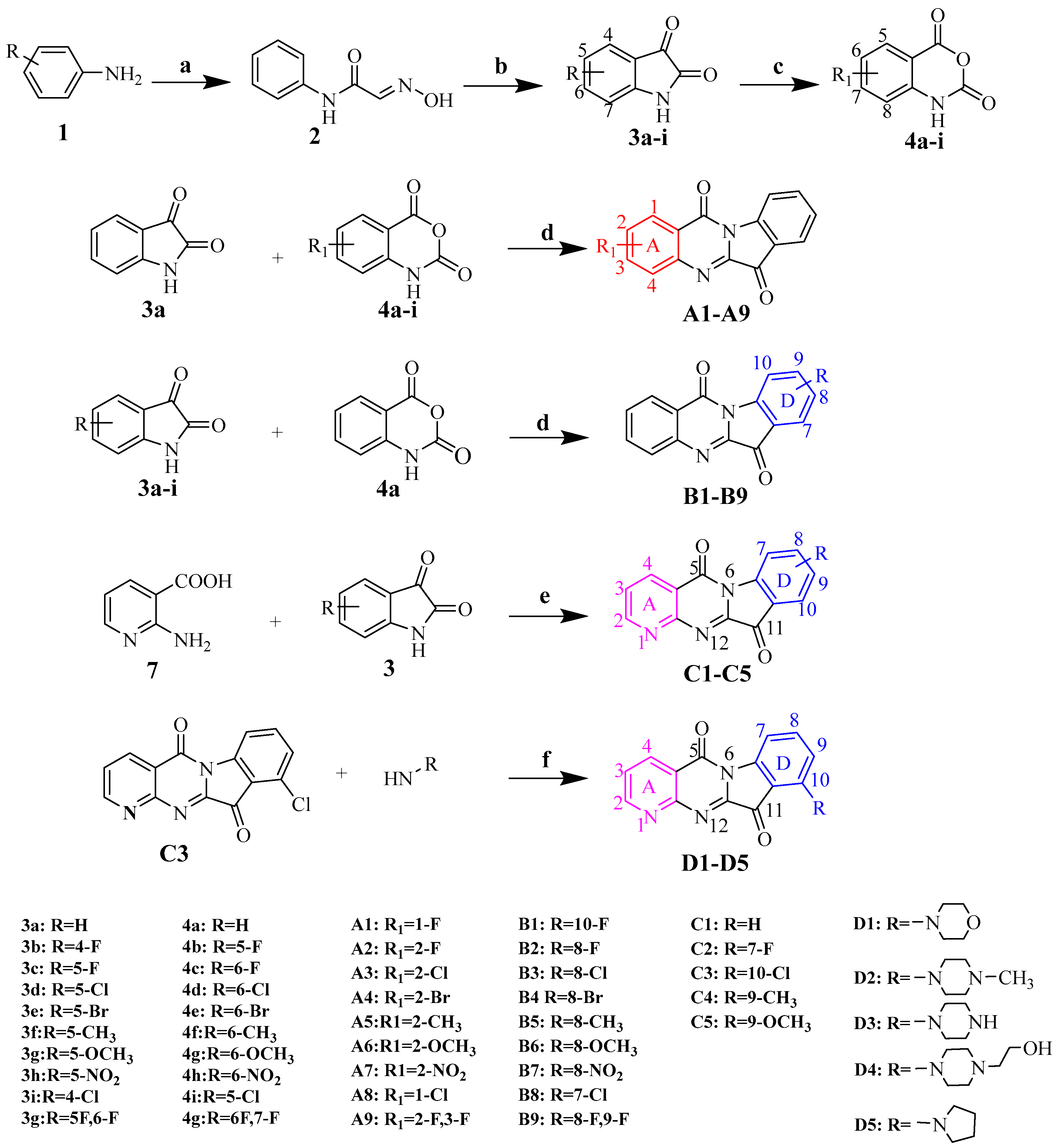

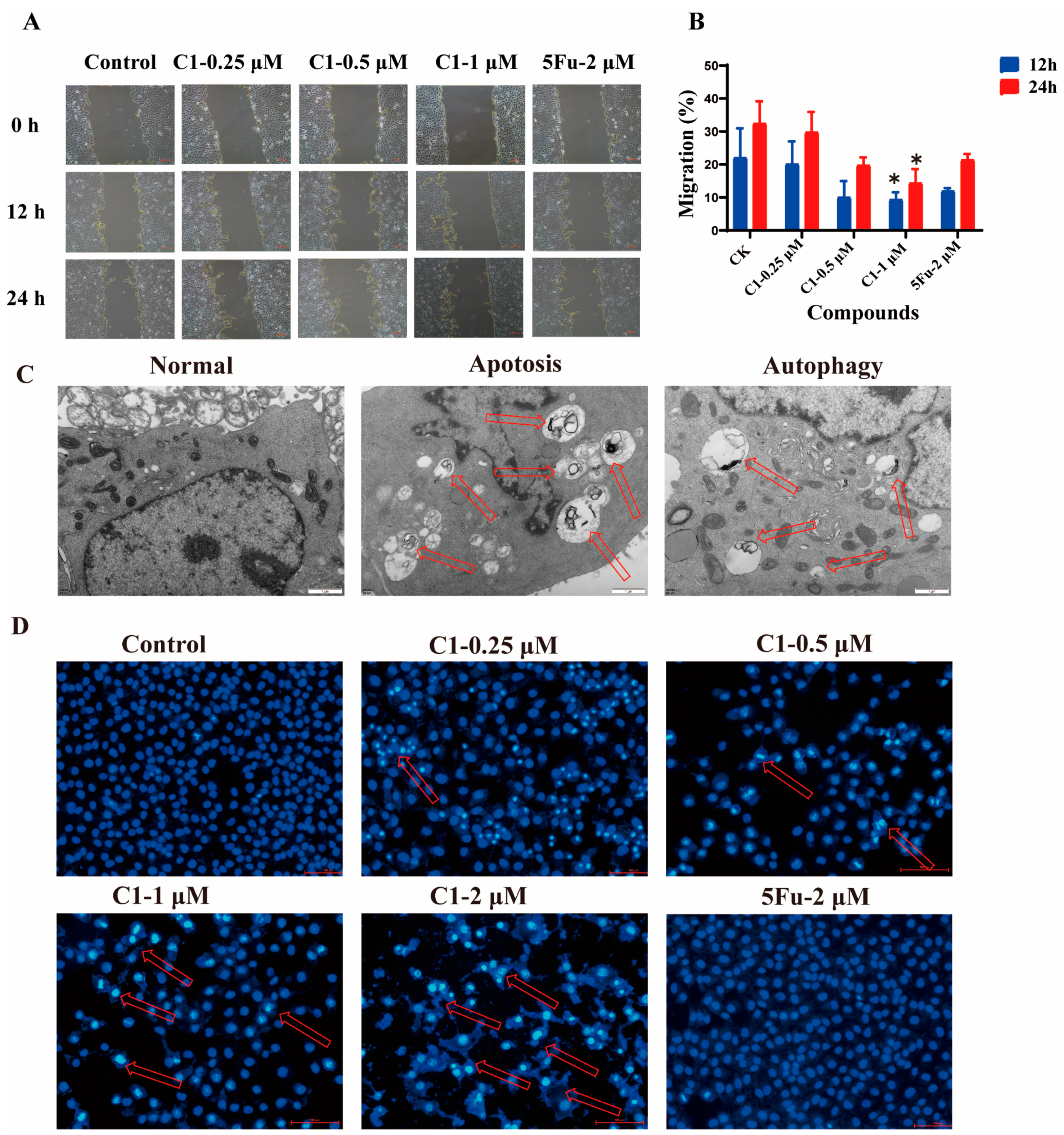
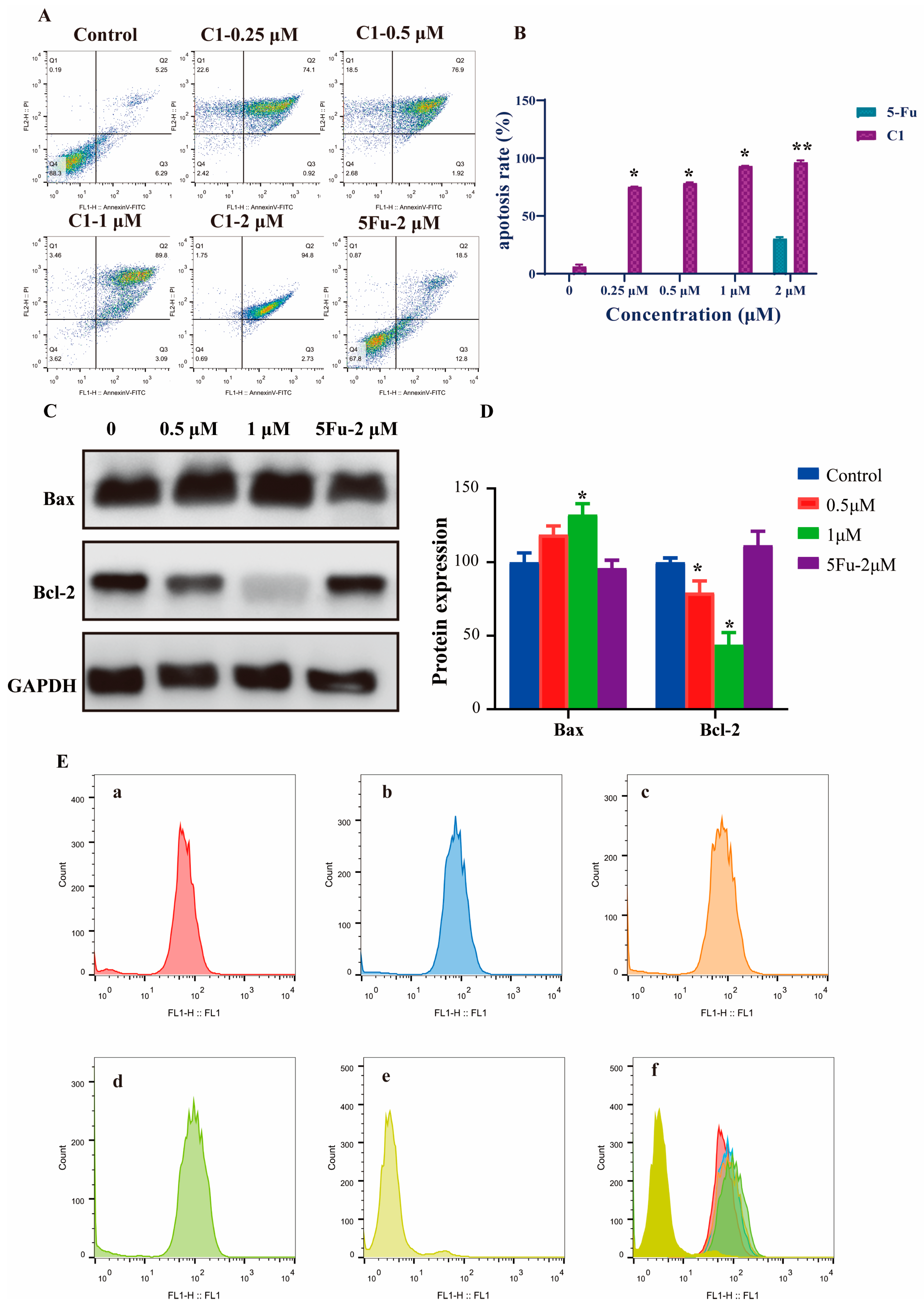



| Compounds | Inhibition Rate 1 (%) ± SD (Concentration: 10 μM) | |||
|---|---|---|---|---|
| A549 | K562 | HepG2 | PC3 | |
| A1 | 73.73 ± 1.45 | 48.38 ± 0.11 | 21.22 ± 2.00 | 61.88 ± 1.97 |
| A2 | 59.26 ± 1.12 | 46.57 ± 1.37 | 25.19 ± 3.04 | 52.87 ± 0.82 |
| A3 | 27.23 ± 0.66 | 16.64 ± 3.22 | 19.67 ± 2.38 | 45.90 ± 2.24 |
| A4 | 36.64 ± 3.53 | 23.78 ± 0.97 | 22.21 ± 0.62 | 34.44 ± 1.61 |
| A5 | 23.55 ± 1.00 | 25.89 ± 1.53 | 27.35 ± 2.55 | 60.00 ± 2.98 |
| A6 | 31.79 ± 2.47 | 31.25 ± 0.18 | 17.43 ± 1.22 | 47.79 ± 1.08 |
| A7 | 27.42 ± 3.02 | 31.39 ± 1.38 | 20.09 ± 0.96 | 69.14 ± 0.50 |
| A8 | 57.43 ± 1.32 | 24.45 ± 2.34 | 25.76 ± 1.65 | 50.89 ± 1.24 |
| A9 | 18.03 ± 1.66 | 7.84 ± 2.22 | 20.45 ± 2.88 | 52.83 ± 3.93 |
| B1 | 67.27 ± 2.79 | 73.94 ± 0.93 | 76.39 ± 2.43 | 66.17 ± 4.20 |
| B2 | 96.22 ± 0.49 | 88.82 ± 1.23 | 38.27 ± 1.39 | 72.52 ± 0.80 |
| B3 | 77.37 ± 0.54 | 82.44 ± 1.69 | 23.48 ± 2.82 | 58.55 ± 2.63 |
| B4 | 57.27 ± 2.54 | 77.36 ± 0.77 | 36.26 ± 1.66 | 64.09 ± 0.43 |
| B5 | 31.79 ± 2.47 | 26.68 ± 3.09 | 17.43 ± 1.22 | 47.79 ± 1.08 |
| B6 | 58.58 ± 1.19 | 66.96 ± 1.16 | 29.87 ± 1.75 | 56.72 ± 1.03 |
| B7 | 91.38 ± 2.74 | 95.85 ± 0.08 | 52.52 ± 2.86 | 81.06 ± 3.96 |
| B8 | 82.58 ± 0.82 | 44.21 ± 3.94 | 12.28 ± 0.67 | 56.73 ± 4.68 |
| B9 | 95.60 ± 0.59 | 96.25 ± 0.41 | 15.50 ± 2.36 | 98.21 ± 0.42 |
| C1 | 96.78 ± 0.59 | 98.31 ± 0.74 | 77.19 ± 1.09 | 92.85 ± 0.79 |
| C2 | 96.33 ± 0.67 | 98.79 ± 0.14 | 76.33 ± 2.23 | 99.32 ± 0.25 |
| C3 | 96.45 ± 1.13 | 99.20 ± 0.22 | 82.12 ± 1.50 | 99.39 ± 0.01 |
| C4 | 96.67 ± 0.57 | 78.96 ± 1.71 | 32.95 ± 2.05 | 81.63 ± 0.03 |
| C5 | 96.64 ± 0.66 | 98.93 ± 0.29 | 78.48 ± 3.26 | 97.52 ± 0.13 |
| D1 | 23.09 ± 4.21 | 14.25 ± 1.97 | 17.04 ± 1.12 | 32.95 ± 8.44 |
| D2 | 16.54 ± 3.83 | 5.64 ± 1.18 | 16.54 ± 3.83 | 32.01 ± 2.66 |
| D3 | 56.38 ± 6.71 | 42.95 ± 1.19 | 24.93 ± 0.78 | 64.50 ± 1.48 |
| D4 | 50.47 ± 3.27 | 17.65 ± 5.49 | 21.44 ± 6.74 | 44.25 ± 3.23 |
| D5 | 22.36 ± 0.62 | 6.10 ± 1.12 | 19.29 ± 6.51 | 25.76 ± 7.78 |
| TRYP 2 | 52.26 ± 0.72 | 50.85 ± 2.41 | 42.87 ± 1.60 | 59.01 ± 2.70 |
| 5-Fu 3 | 64.31 ± 2.42 | 56.38 ± 2.07 | 33.39 ± 2.42 | 61.70 ± 3.40 |
| Compounds | IC50 ± SD 1 (μM) | |||
|---|---|---|---|---|
| A549 | K562 | HepG2 | PC3 | |
| A1 | 5.45 ± 0.46 | 6.86 ± 0.10 | 6.26 ± 0.59 | 12.36 ± 0.85 |
| B1 | 6.45 ± 1.26 | 3.69 ± 0.26 | 5.89 ± 0.48 | 7.05 ± 1.23 |
| B2 | 2.36 ± 0.80 | 2.66 ± 0.10 | 1.97 ± 0.77 | 10.59 ± 0.55 |
| B3 | 4.21 ± 0.36 | 3.67 ± 0.39 | 2.95 ± 0.92 | 8.48 ± 3.98 |
| B7 | 6.88 ± 3.51 | 8.05 ± 0.01 | 7.89 ± 0.58 | 11.83 ± 0.19 |
| B8 | 2.34 ± 0.65 | 6.77 ± 0.67 | 5.63 ± 1.56 | 9.70 ± 1.66 |
| B9 | 2.15 ± 0.43 | 3.31 ± 0.23 | 9.84 ± 0.68 | 10.44 ± 0.87 |
| C1 | 0.55 ± 0.33 | 1.02 ± 0.09 | 0.91 ± 0.79 | 1.67 ± 0.12 |
| C2 | 1.04 ± 0.04 | 1.53 ± 0.05 | 1.85 ± 0.87 | 1.61 ± 0.05 |
| C3 | 0.90 ± 0.12 | 0.83 ± 0.10 | 0.97 ± 0.85 | 1.07 ± 0.06 |
| C4 | 1.08 ± 0.23 | 1.97 ± 0.28 | 1.77 ± 0.95 | 2.48 ± 0.46 |
| C5 | 1.29 ± 0.31 | 1.86 ± 0.02 | 1.33 ± 0.56 | 1.30 ± 0.01 |
| D3 | 8.12 ± 1.26 | 5.50 ± 0.47 | 5.67 ± 0.84 | 10.13 ± 0.18 |
| D4 | 9.16 ± 0.95 | 12.85 ± 1.54 | 10.92 ± 1.84 | 13.85 ± 0.95 |
| TRYP | 8.25 ± 0.69 | 12.04 ± 0.69 | 9.51 ± 0.23 | 14.52 ± 3.29 |
| 5-Fu | 6.30 ± 1.62 | 8.09 ± 2.05 | 8.53 ± 0.95 | 11.09 ± 1.40 |
Disclaimer/Publisher’s Note: The statements, opinions and data contained in all publications are solely those of the individual author(s) and contributor(s) and not of MDPI and/or the editor(s). MDPI and/or the editor(s) disclaim responsibility for any injury to people or property resulting from any ideas, methods, instructions or products referred to in the content. |
© 2023 by the authors. Licensee MDPI, Basel, Switzerland. This article is an open access article distributed under the terms and conditions of the Creative Commons Attribution (CC BY) license (https://creativecommons.org/licenses/by/4.0/).
Share and Cite
Zou, Y.; Zhang, G.; Li, C.; Long, H.; Chen, D.; Li, Z.; Ouyang, G.; Zhang, W.; Zhang, Y.; Wang, Z. Discovery of Tryptanthrin and Its Derivatives and Its Activities against NSCLC In Vitro via Both Apoptosis and Autophagy Pathways. Int. J. Mol. Sci. 2023, 24, 1450. https://doi.org/10.3390/ijms24021450
Zou Y, Zhang G, Li C, Long H, Chen D, Li Z, Ouyang G, Zhang W, Zhang Y, Wang Z. Discovery of Tryptanthrin and Its Derivatives and Its Activities against NSCLC In Vitro via Both Apoptosis and Autophagy Pathways. International Journal of Molecular Sciences. 2023; 24(2):1450. https://doi.org/10.3390/ijms24021450
Chicago/Turabian StyleZou, Yayu, Guanglong Zhang, Chengpeng Li, Haitao Long, Danping Chen, Zhurui Li, Guiping Ouyang, Wenjing Zhang, Yi Zhang, and Zhenchao Wang. 2023. "Discovery of Tryptanthrin and Its Derivatives and Its Activities against NSCLC In Vitro via Both Apoptosis and Autophagy Pathways" International Journal of Molecular Sciences 24, no. 2: 1450. https://doi.org/10.3390/ijms24021450
APA StyleZou, Y., Zhang, G., Li, C., Long, H., Chen, D., Li, Z., Ouyang, G., Zhang, W., Zhang, Y., & Wang, Z. (2023). Discovery of Tryptanthrin and Its Derivatives and Its Activities against NSCLC In Vitro via Both Apoptosis and Autophagy Pathways. International Journal of Molecular Sciences, 24(2), 1450. https://doi.org/10.3390/ijms24021450






